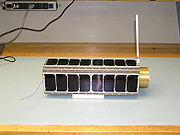
GeneSat-1
Encyclopedia
GeneSat-1 is a fully automated, miniature spaceflight system that provides life support for bacterium. The system was launched into orbit on December 16, 2006 from Wallops Flight Facility
. GeneSat-1 began to transmit data on its first pass over the mission's California ground station. The nanosatellite contains onboard micro-laboratory systems that such as sensors and optical systems that can detect proteins that are the products of specific genetic activity. Knowledge gained from GeneSat-1 is intended to aid scientific understanding of how spaceflight affects the human body.
The nanosatellite contains onboard micro-laboratory systems that such as sensors and optical systems that can detect proteins that are the products of specific genetic activity. Knowledge gained from GeneSat-1 is intended to aid scientific understanding of how spaceflight affects the human body.
Weighing 5 kilograms, the miniature laboratory was a secondary payload on an Air Force four-stage Minotaur 1 rocket that delivered the Air Force TacSat 2 satellite to orbit.
In the development of the GeneSat satellite class (at a fraction of what it normally costs to conduct a mission in space), Ames Research Center (Small Spacecraft Office) collaborated with organisations in Industry and also universities local to the center. It is NASA's first fully automated, self-contained biological spaceflight experiment on a satellite of its size.
Wallops Flight Facility
Wallops Flight Facility , located on the Eastern Shore of Virginia, is operated by NASA’s Goddard Space Flight Center, primarily as a rocket launch site to support science and exploration missions for NASA and other U.S. government agencies...
. GeneSat-1 began to transmit data on its first pass over the mission's California ground station.

Weighing 5 kilograms, the miniature laboratory was a secondary payload on an Air Force four-stage Minotaur 1 rocket that delivered the Air Force TacSat 2 satellite to orbit.
In the development of the GeneSat satellite class (at a fraction of what it normally costs to conduct a mission in space), Ames Research Center (Small Spacecraft Office) collaborated with organisations in Industry and also universities local to the center. It is NASA's first fully automated, self-contained biological spaceflight experiment on a satellite of its size.
External links
- a list from the NASA database retrieved 08:55(UTC) October 24, 2011
- GeneSat-1 mission dashboard Santa Clara University Robotics Systems Laboratory retrieved 08:19 24.10.2011

